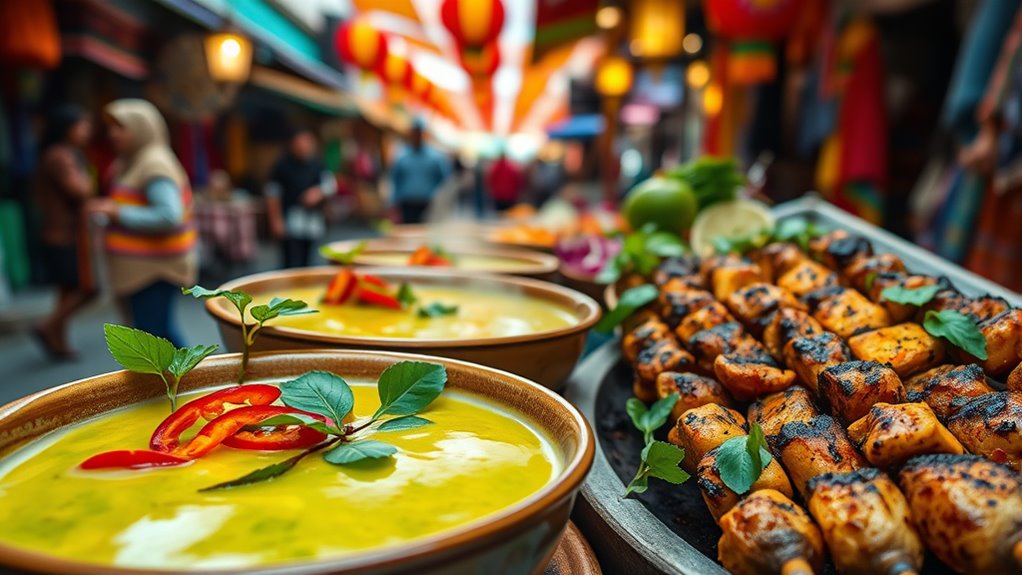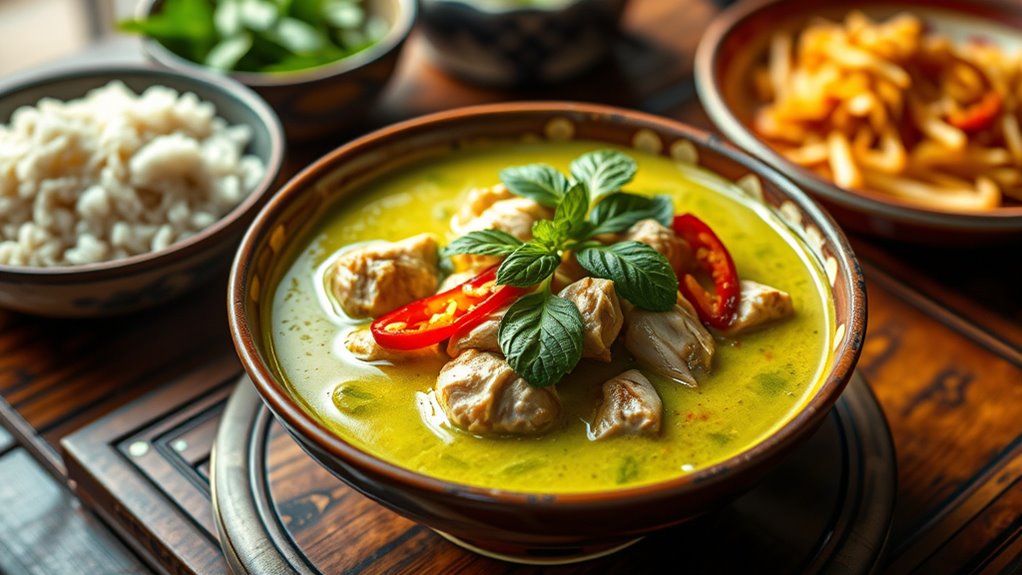If you’re craving an authentic culinary adventure, try exploring Vietnam’s vibrant street food scene. Its dishes reflect a rich history of regional influences, from fragrant herbs in pho to lively banh mi sandwiches. Participating in these food traditions gives you insights into local culture, values, and daily life beyond tourist spots. If you continue exploring, you’ll uncover how food connects people, history, and identity—so get ready for a flavorful journey.
Key Takeaways
- Explore countries whose street food reflects unique regional ingredients and cooking techniques.
- Consider destinations where food traditions are deeply rooted and passed down through generations.
- Choose locations offering authentic, affordable street eats in vibrant markets and local stalls.
- Seek culinary experiences that reveal cultural stories and social values through flavors.
- Prioritize countries where food acts as a gateway to understanding local history and community identity.

Have you ever wondered how food can be your passport to new cultures? When you travel, tasting local dishes becomes one of the most authentic ways to connect with a place’s identity. One of the best ways to immerse yourself in a country’s culinary scene is through its street food. These vibrant, bustling markets and roadside stalls serve up dishes that mirror the heart of local culinary traditions. Instead of fancy restaurants, street food offers an unfiltered glimpse into what people eat daily, revealing flavors passed down through generations. Whether it’s spicy tacos in Mexico City, savory satay skewers in Bali, or crispy falafel in Cairo, these foods tell stories about history, climate, and cultural influences. As you explore street food, you’ll notice how each bite embodies the essence of the community, often with recipes adapted over time to suit local tastes and ingredients.
When you indulge in street food, you’re not just eating—you’re participating in a living tradition. Vendors often have recipes that their families have perfected over decades, handed down through generations. This dedication keeps culinary traditions alive and vibrant, allowing you to experience them firsthand. Sampling street food means you’re tasting more than just food; you’re absorbing a country’s history and social fabric. The communal aspect of street markets, where locals and travelers gather in the same space, fosters a shared appreciation for these culinary traditions. Plus, the casual nature of street food makes it accessible and affordable, giving you the chance to try a variety of dishes without breaking the bank.
Understanding these culinary traditions also helps you appreciate the regional ingredients and techniques that define a country’s cuisine. For example, the use of fresh herbs in Vietnamese pho or the grilling methods in Argentinian asado reflect local resources and cultural values. By immersing yourself in these street food scenes, you gain insights into how a society views food—whether as comfort, celebration, or everyday sustenance. It’s about more than just satisfying hunger; it’s about experiencing a culture through its most accessible, authentic flavors.
In the end, exploring street food and the culinary traditions behind them can change how you see a country. It’s a direct, sensory connection to the people and their history. So next time you travel, don’t shy away from those crowded stalls and roadside vendors. Embrace the chaos, try the dishes, and let your taste buds guide you through the rich, delicious stories that define a place. That’s how food becomes your passport—by opening doors to worlds you might never have discovered otherwise. A comprehensive understanding of culinary traditions enriches your travel experience and deepens your connection to the culture.
Frequently Asked Questions
What Is the Most Authentic Dish to Try in Each Country?
For cultural authenticity and regional specialties, you should try Italy’s Osso Buco, a hearty veal dish rich in tradition. In Japan, savor authentic Sushi from a local fish market for true regional authenticity. In Mexico, indulge in Tacos al Pastor, capturing vibrant flavors and cultural roots. Each country’s most authentic dish reflects its history and regional pride, offering you a genuine taste of its culinary heritage.
How Do I Find Local Food Festivals Abroad?
Think of local food festivals as hidden gems waiting to be uncovered. To find them abroad, you should explore cultural celebrations, ask locals, and check online platforms like Eventbrite or Meetup. Join culinary tours or follow social media pages dedicated to food events in your destination. These steps help you dive deep into authentic flavors and connect with communities, making your trip a delicious adventure filled with unforgettable tastes.
Are There Dietary Restrictions Common in Certain Cuisines?
Many cuisines include dietary restrictions, so you’ll find vegetarian options and gluten-free accommodations often available. For example, Indian cuisine offers plenty of vegetarian dishes, while Japanese and Mediterranean cuisines tend to have gluten-free choices. When traveling, it’s smart to learn key phrases or use translation apps to communicate your needs. Always ask locals or restaurant staff about ingredients to avoid allergens or restrictions, ensuring you enjoy your culinary experience safely.
What Safety Tips Should I Follow When Trying Street Food?
Think of street food as a treasure map—exciting but needing careful navigation. Always check hygiene standards, spotting clean stalls and fresh ingredients. Be allergy-aware by asking about ingredients and avoiding cross-contamination. Use hand sanitizer before eating, and opt for vendors with a busy crowd—proof of good hygiene. Trust your instincts; if something feels off, it’s okay to pass. Your safety is the real culinary jackpot.
How Can I Learn to Cook Traditional Dishes From Different Countries?
To learn cultural cooking from different countries, start by researching authentic recipes and cooking techniques. You can watch online tutorials or join local cooking classes focused on traditional dishes. Pay close attention to ingredient sourcing, using authentic spices and regional products whenever possible. Practice regularly, experiment with flavors, and immerse yourself in the culinary culture. This hands-on approach helps you master traditional dishes and gain a genuine understanding of each cuisine.
Conclusion
So, with so many tantalizing cuisines waiting to be explored, which one will you choose to experience next? Imagine the flavors, the aromas, the stories behind each dish—don’t you want to taste it all? Food travel isn’t just about eating; it’s about discovering new cultures and creating unforgettable memories. Are you ready to take that leap and set out on your culinary adventure? The world’s delicious secrets are calling—are you listening?
Joy, as our Editor in Chief, ensures the highest standard of content. Her talent in writing is complemented by her attention to detail and passion for literature and culture. Joy’s expertise and love for the English language shine through in her editorial work, making each piece a testament to quality and clarity.










